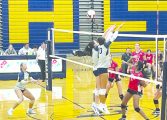The FAA judges looked at the work and reminisced about their early days learning art in school; that is, if they were lucky enough to have an art program. Kritzer recalled the early days in Fluvanna before art was added to the curriculum. With the arts often the first program to get the ax, teachers like Kritzer keep pushing to value art’s place in the classroom and culture. The judges – artists themselves – wished they had the advantages children have today to learn the fundamentals of art early.
Kritzer sees the individuality in her students and their work, and gives them the support they need not only to complete a project, but also to be proud of the final product. One of the FAA judges, Brenda Lee Cohen, was a master at looking past any imperfections and seeing the colors, shapes and ideas behind the students’ work.
The seventh grade students showed promise in their work. Avery Cooper’s “The Mask” stood out as a surrealistic piece that showed advanced symbolic thinking. It consisted of a two-part mask, half of which was stripped away from the face, showing a raw layer beneath the happy exterior.
Emmanuel Johnson’s “Potato chip bag” generated attention for its floating chips and bag, while “Darth Vader” shone for its attention to facial features and detail. John Layne’s “Homer Simpson” and Barrett Dyke’s “Happy” were also among the well-executed sculptures.
Some of the spider web designs done by the seventh grade were striking. Jackson Landsberg’s web was stunning, his choice of colors right on target, and his execution flawless. Willow Harrison’s web was also well-executed with clean lines and good graphics.
“I hope my students learn that art is not just for ‘artsy’ kids. There are real skills and tools that will make anyone’s art projects look better,” said Kritzer, whose positive outlook and philosophy gives her kids a solid foundation in art. “The only students who aren’t successful are students who won’t try. I love to help students improve their skills, and anyone who wants to do well will eventually see results.”
She believes that support and encouragement are the keys to helping students achieve their goals.
“Encouragement is essential. It is important to share the attitude that art is for everyone, and there is no perfect art student,” said Kritzer. “For some, art is manipulating materials and tools to solve the problem of space. For others, it is a way to express opinions and ideas that challenge. Both are valid and valuable, and I enjoy my mechanical artists as much as my expressive artists.”
The judges were amazed by the diversity in creation. No two sculptures, webs or lines looked alike.
“I am never disappointed,” Kritzer said. “As always, I found myself genuinely surprised by some of the solutions and ideas generated by students. There is a real depth of talent throughout the fifth grade. I have some rising superstars in sixth grade, and I think some of my seventh graders even surprised themselves this year.”
Kritzer supports the theory that through exploration and creation, her students discover something within themselves they never knew existed.




